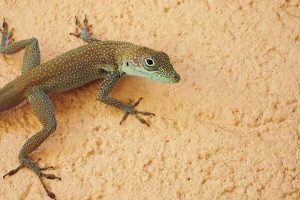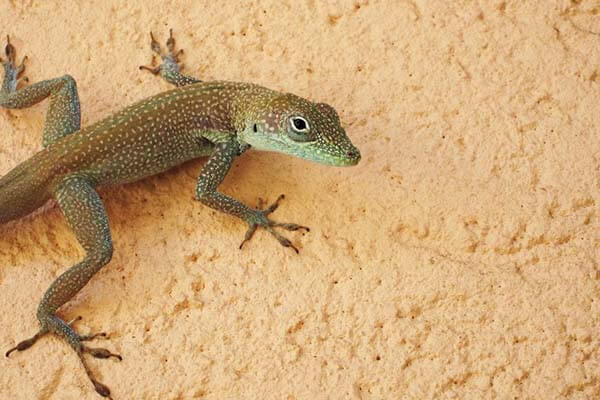Lizards
lizard, (suborder Sauria), any of more than 5,500 species of reptiles belonging in the order Squamata (which also includes snakes, suborder Serpentes).
Lizards are scaly-skinned reptiles that are usually distinguished from snakes by the possession of legs, movable eyelids, and external ear openings. However, some traditional (that is, non-snake) lizards lack one or more of these features.
For example, limb degeneration and loss has occurred in glass lizards (Ophisaurus) and other lizard groups. Movable eyelids have been lost in some geckos, skinks, and night lizards. External ear openings have disappeared in some species in the genera Holbrookia and Cophosaurus.
Most of the living species of lizards inhabit warm regions, but some are found near the Arctic Circle in Eurasia and others range to the southern tip of South America.
Snakes arose from lizards and are thus considered to be a highly specialized group of limbless lizards. In addition to those traits they have in common with non-snake lizards, snakes are often separated from other lizards in popular literature because they share a set of unique traits that are relatively easy to observe. For a full description of snakes, see snake.
General Lizard features
Lizards are by far the most diverse group of modern reptiles in body shape and size. They range from 2 cm (0.8 inch) snout to vent in geckos (family Gekkonidae) to 3 metres (10 feet) in total length in monitor lizards (family Varanidae).
The weight of adult lizards ranges from less than 0.5 gram (0.02 ounce) to more than 150 kg (330 pounds). The popular conception of a lizard as a scampering reptile about 30 cm (12 inches) in total length with a slender tail may be applied accurately only to a small number of species.
Representatives of several families are limbless and resemble snakes, whereas others have long hind legs that permit bipedal locomotion. Male lizards may be outfitted with a wide array of ornamentation—such as extensible throat fans and frills, throat spines, horns or casques on the head, and tail crests.
Lizards occupy diverse habitats that range from underground warrens and burrows to the surface and elevated vegetation. Some move slowly and rely on cryptic coloration for protection, whereas others can run swiftly across desert sands.
Lizards of the family Mosasauridae, an extinct group, were strictly marine. Some mosasaurs were giants and grew to lengths of 10 metres (33 feet). One living lizard, the marine iguana (Amblyrhynchus cristatus) of the Galapagos Islands, feeds on algae in the sea.
However, it spends much of its time basking on lava rocks on the islands. No other extant lizard species is marine, but several are partially aquatic and feed on freshwater organisms.
The role lizards play in human ecology is poorly known. Some lizards are sources of food and clothing or agents of pest control, whereas others are pests.
Some larger lizards (such as the iguanas [Iguana and Ctenosaura] of Mexico, Central America, and South America) are eaten and are an important food source. Others are used for leather goods. Monitor lizards and tegus (family Teiidae) are harvested for their skins, and these skins have a major effect on local economies of rural areas in Third World countries.
Although lizards are often portrayed as insectivores, many also consume small vertebrates and at least some plant material; strict herbivory has evolved independently in several groups of lizards. Nevertheless, lizards eat large numbers of insects and other invertebrates, particularly in the tropics and in deserts.
These insect-control services affect humans in many subtle ways; however, such effects have not been well studied. Large predatory lizards (such as monitors and tegus) can be pests—often preying on farm animals or stealing chicken eggs—that affect the livelihoods of ranchers and farmers.
Some relatively small lizard species, such as geckos, have not only colonized many islands by rafting with humans on boats but have also invaded cities and towns throughout the world.
For example, throughout Brazil, one of the best-known lizards, the Mediterranean gecko (Hemidactylus mabouia), is so common in houses and buildings that most Brazilians know more about it, based on their own observations, than they know about any of the endemic species. As is the case with many introduced lizards, the Mediterranean gecko appears to do very well living with people in disturbed areas but does not seem to invade undisturbed habitats.
For the most part, lizards are not disease vectors and pose little danger to humans who take proper precautions when handling them. Lizards are often infected with various parasites, including a type of malaria, but these parasites tend to be species specific.
Salmonella bacteria may be transmitted from a lizard to a human, particularly if the lizard is placed in a person’s mouth. Tuberculosis (Mycobacterium tuberculosis) and some viral and fungal infections may also pass from lizard to human. Persons handling lizards are advised to practice good personal hygiene.
Only two species, the Gila monster (Heloderma suspectum) of the southwestern United States and northwestern Mexico and the Mexican beaded lizard (H. horridum) of western Mexico, are venomous. Both species bite humans only when provoked, and fatalities are very rare.
Among the most harmless of lizards are geckos, which are falsely believed to be highly venomous by many indigenous cultures throughout the world. Reasons for this suspicion are unclear; however, the geckos’ nocturnal activity, elliptical pupils, and ability to walk up smooth vertical surfaces could make them seem supernatural to some cultures.
Lizards are also valued as subjects for biological research. Their varied modes of reproduction and their ability to regulate body temperatures are two of many areas studied by comparative physiologists (see thermoregulation). The great abundance and observability of numerous species make them ideal subjects for ecologists and ethologists. The ability of some species to regenerate broken tails has led to their use as research subjects by behavioral ecologists and developmental biologists. Since they are relatively clean and easy to keep, lizards are also quite popular as house pets.
Natural Lizard history
Lizard Life cycle
Most lizards reproduce by laying eggs. In some small species, the number of eggs is rather uniform for each laying or clutch. For example, all anoles (Anolis) lay but a single egg at a time, many geckos lay one or two eggs (depending upon the species), and some skinks have clutches of two eggs. A more general rule is that clutch size varies with the size, age, and condition of the mother.
A clutch of four to eight eggs may be considered typical, but large lizards such as the iguanas may lay 50 or more eggs at one time. Lizard eggs are usually leathery-shelled and porous; they can expand by the absorption of moisture as the embryos grow. An exception occurs in the majority of egg-laying geckos, whose eggs have shells that harden soon after they are deposited and then show no further change in size or shape.
Embryonic development and sex determination in Lizards
Viviparity, or the birthing of live young, occurs in some lizard species. For skinks, this is true for about one-third of the species, many of which live in tropical climates. In most other families that have live-bearing representatives, the species that are frequently exposed to cold conditions—either at high altitude or at extreme latitude—tend to be live-bearers.
For example, all New Zealand geckos give birth to live young, yet all other geckos lay eggs. A great diversity of mechanisms exists that results in the production of live young. In some lizards the only difference between egg laying (oviparity) and live bearing (viviparity) is that shells never form around the “eggs.”
The female retains them inside the oviduct until development is complete, and each egg already contains all of the energy necessary for development in its large yolk. In these cases, no additional nutrients pass from the mother to the offspring.
In other lizards, eggs released from the ovary contain most, but not all, of the energy necessary for development in the yolk. Several kinds of placentae can develop, depending on the species of lizard. The result is that some nutrients pass from the mother to the offspring during development.
In just a few species, such as Mabuya heathi, tiny eggs with almost no yolk are released from the ovary and deposited in the oviduct. An advanced and complex placenta develops, and more than 99 percent of the nutrients required for embryonic development pass from the mother to the offspring. In these species the gestation period is usually very long ( 8–12 months).
Sex in most lizards is genetically and rigidly determined; a hatchling normally has either male or female reproductive structures. In representatives of most iguanian lizard families (Iguania) and in some species of whiptails, tegus, geckos, and skinks, the males have dissimilar sex chromosomes, comparable to the sex-chromosome system of most mammals. Some female geckos and wall lizards and all monitor lizards have sex-chromosome differences that are similar to those found in snakes.
In a few lizard species (some iguanids, geckos, and wall lizards), no sex chromosomes exist. They rely on temperature-dependent sex determination (TSD)—that is, temperatures occurring within the nest during egg development control the sex of the hatchlings.
Lizard Parthenogenesis
Most lizard populations are evenly divided between females and males. Deviations from this pattern are found in parthenogenetic species, in which the young are produced from unfertilized eggs.
Parthenogenesis in lizards was first discovered in all-female races of Lacerta in the Caucasus, but it is now known to occur in all-female species of whiptail lizards (Aspidoscelis) in the southwestern United States and parts of Mexico, several other Teiidae and Gymnophthalmidae (spectacled lizards or microteiids) in South America, and a few Gekkonidae.
Parthenogenetic lizards appear to live in areas that are ecologically marginal for representatives of their genera. In Aspidoscelis and several other parthenogenetic species, convincing evidence exists that parthenogenetic forms arose through the hybridization of two bisexual species.
The number of chromosomes in such species is usually double that in sexually reproducing species, but in a few cases, the number of chromosomes is triple. This results from the mating of a sexually reproducing species with one that is parthenogenetic. These offspring are called allotriploid because they represent a backcross that produces three sets of chromosomes.
Lizards Parental care
Parental care among lizards tends to be minimal following egg deposition, but there are striking exceptions. Many species dig holes in which the eggs are placed, whereas others bury them under leaf litter or deposit them in crannies of trees or caves.
In contrast, females of some species, notably the five-lined skink (Eumeces fasciatus) of the United States and many of its relatives, remain with their eggs throughout the incubation time (about six weeks); they leave the clutch infrequently to feed. These skinks turn their eggs regularly and, if the eggs are experimentally scattered, will return them to the nest cavity.
As soon as the young disperse, family ties are severed. Glass lizards (Ophisaurus, family Anguidae) appear to do the same thing. In addition, a number of viviparous lizards remove and eat the placental membranes from young when they are born.
In Australia, juvenile sleepy lizards (Tiliqua rugosa) remain in their mother’s home range for an extended period, and this behaviour suggests that they gain a survival advantage by doing so.
Female sleepy lizards and those of the Baudin Island spiny-tailed skink (Egernia stokesii aethiops) recognize their own offspring on the basis of chemical signals. Consequently, parental care in lizards may be more widespread than previously thought. Nevertheless, since recognition systems are subtle, they are difficult to study.
Certain lizards, particularly some species of Gekkonidae, are known to be communal egg layers, with many females depositing their eggs at the same site. In addition, it appears that the same individual female may return to a particular site throughout her lifetime to deposit clutches of eggs.
In Tropidurus semitaeniatus and T. hispidus, two species of South American ground lizards, females nest communally under slabs of rock situated on top of large boulders. In this specialized habitat, only a few appropriate nest sites are available, and thus they are limited resources.
Males appear to take advantage of this situation, especially if nesting sites are located within their territories. It is likely that if a male defends a good nesting site, he should have access to more females than males who govern areas without high-quality nesting sites.

- PestPro’s Rat Control Services in Nairobi and the rest of Kenya
- PestPro Pest Control Services Nairobi Kenya on Facebook
- Pest control and fumigation services near me in Nairobi, coverage areas
- PestPro’s Rat Control Services in Nairobi and the rest of Kenya
- Pest Control Services By Bestcare Services Nairobi Kenya
Get the best pest control services in Kenya, courtesy of Bestcare Pest Control Nairobi. We offer pest control in Nairobi, Nakuru, Kiambu, Eldoret and the rest of Kenya, forMice,Rats, Moles, Weevils, Snakes, Bedbugs, termites control, flea control, flies control, ants treatment, and Cocroaches removal.
Also eliminate birds, moths, wasps, and more pests. We also offer fumigation services, cleaning services, garden spraying and farm treatment. Our pest control services are available for domestic and residential environments and also for Commercial and business environments. We serve homes, Offices, Schools, Hotels, and community spaces.

